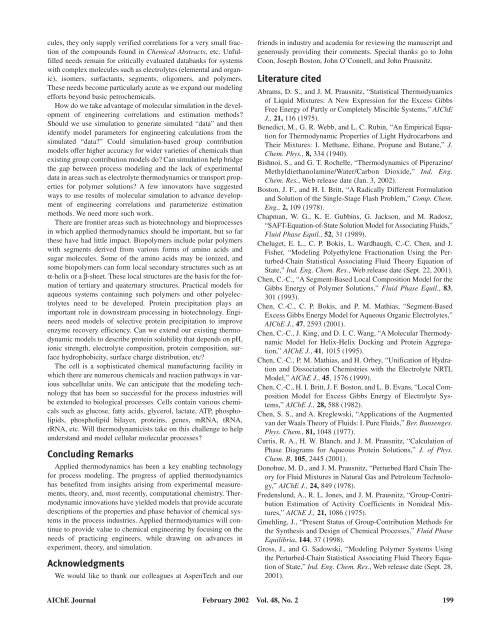Applied Thermodynamics for Process Modeling
Applied Thermodynamics for Process Modeling
Applied Thermodynamics for Process Modeling
Create successful ePaper yourself
Turn your PDF publications into a flip-book with our unique Google optimized e-Paper software.
cules, they only supply verified correlations <strong>for</strong> a very small fraction<br />
of the compounds found in Chemical Abstracts, etc. Unfulfilled<br />
needs remain <strong>for</strong> critically evaluated databanks <strong>for</strong> systems<br />
with complex molecules such as electrolytes (elemental and organic),<br />
isomers, surfactants, segments, oligomers, and polymers.<br />
These needs become particularly acute as we expand our modeling<br />
ef<strong>for</strong>ts beyond basic petrochemicals.<br />
How do we take advantage of molecular simulation in the development<br />
of engineering correlations and estimation methods?<br />
Should we use simulation to generate simulated “data” and then<br />
identify model parameters <strong>for</strong> engineering calculations from the<br />
simulated “data?” Could simulation-based group contribution<br />
models offer higher accuracy <strong>for</strong> wider varieties of chemicals than<br />
existing group contribution models do? Can simulation help bridge<br />
the gap between process modeling and the lack of experimental<br />
data in areas such as electrolyte thermodynamics or transport properties<br />
<strong>for</strong> polymer solutions? A few innovators have suggested<br />
ways to use results of molecular simulation to advance development<br />
of engineering correlations and parameterize estimation<br />
methods. We need more such work.<br />
There are frontier areas such as biotechnology and bioprocesses<br />
in which applied thermodynamics should be important, but so far<br />
these have had little impact. Biopolymers include polar polymers<br />
with segments derived from various <strong>for</strong>ms of amino acids and<br />
sugar molecules. Some of the amino acids may be ionized, and<br />
some biopolymers can <strong>for</strong>m local secondary structures such as an<br />
α-helix or a β-sheet. These local structures are the basis <strong>for</strong> the <strong>for</strong>mation<br />
of tertiary and quaternary structures. Practical models <strong>for</strong><br />
aqueous systems containing such polymers and other polyelectrolytes<br />
need to be developed. Protein precipitation plays an<br />
important role in downstream processing in biotechnology. Engineers<br />
need models of selective protein precipitation to improve<br />
enzyme recovery efficiency. Can we extend our existing thermodynamic<br />
models to describe protein solubility that depends on pH,<br />
ionic strength, electrolyte composition, protein composition, surface<br />
hydrophobicity, surface charge distribution, etc?<br />
The cell is a sophisticated chemical manufacturing facility in<br />
which there are numerous chemicals and reaction pathways in various<br />
subcellular units. We can anticipate that the modeling technology<br />
that has been so successful <strong>for</strong> the process industries will<br />
be extended to biological processes. Cells contain various chemicals<br />
such as glucose, fatty acids, glycerol, lactate, ATP, phospholipids,<br />
phospholipid bilayer, proteins, genes, mRNA, tRNA,<br />
rRNA, etc. Will thermodynamicists take on this challenge to help<br />
understand and model cellular molecular processes?<br />
Concluding Remarks<br />
<strong>Applied</strong> thermodynamics has been a key enabling technology<br />
<strong>for</strong> process modeling. The progress of applied thermodynamics<br />
has benefited from insights arising from experimental measurements,<br />
theory, and, most recently, computational chemistry. Thermodynamic<br />
innovations have yielded models that provide accurate<br />
descriptions of the properties and phase behavior of chemical systems<br />
in the process industries. <strong>Applied</strong> thermodynamics will continue<br />
to provide value to chemical engineering by focusing on the<br />
needs of practicing engineers, while drawing on advances in<br />
experiment, theory, and simulation.<br />
Acknowledgments<br />
We would like to thank our colleagues at AspenTech and our<br />
friends in industry and academia <strong>for</strong> reviewing the manuscript and<br />
generously providing their comments. Special thanks go to John<br />
Coon, Joseph Boston, John O’Connell, and John Prausnitz.<br />
Literature cited<br />
Abrams, D. S., and J. M. Prausnitz, “Statistical <strong>Thermodynamics</strong><br />
of Liquid Mixtures: A New Expression <strong>for</strong> the Excess Gibbs<br />
Free Energy of Partly or Completely Miscible Systems,” AIChE<br />
J., 21, 116 (1975).<br />
Benedict, M., G. R. Webb, and L. C. Rubin, “An Empirical Equation<br />
<strong>for</strong> Thermodynamic Properties of Light Hydrocarbons and<br />
Their Mixtures: I. Methane, Ethane, Propane and Butane,” J.<br />
Chem. Phys., 8, 334 (1940).<br />
Bishnoi, S., and G. T. Rochelle, “<strong>Thermodynamics</strong> of Piperazine/<br />
Methyldiethanolamine/Water/Carbon Dioxide,” Ind. Eng.<br />
Chem. Res., Web release date (Jan. 3, 2002).<br />
Boston, J. F., and H. I. Britt, “A Radically Different Formulation<br />
and Solution of the Single-Stage Flash Problem,” Comp. Chem.<br />
Eng., 2, 109 (1978).<br />
Chapman, W. G., K. E. Gubbins, G. Jackson, and M. Radosz,<br />
“SAFT-Equation-of-State Solution Model <strong>for</strong> Associating Fluids,”<br />
Fluid Phase Equil., 52, 31 (1989).<br />
Cheluget, E. L., C. P. Bokis, L. Wardhaugh, C.-C. Chen, and J.<br />
Fisher, “<strong>Modeling</strong> Polyethylene Fractionation Using the Perturbed-Chain<br />
Statistical Associating Fluid Theory Equation of<br />
State,” Ind. Eng. Chem. Res., Web release date (Sept. 22, 2001).<br />
Chen, C.-C., “A Segment-Based Local Composition Model <strong>for</strong> the<br />
Gibbs Energy of Polymer Solutions,” Fluid Phase Equil., 83,<br />
301 (1993).<br />
Chen, C.-C., C. P. Bokis, and P. M. Mathias, “Segment-Based<br />
Excess Gibbs Energy Model <strong>for</strong> Aqueous Organic Electrolytes,”<br />
AIChE J., 47, 2593 (2001).<br />
Chen, C.-C., J. King, and D. I. C. Wang, “A Molecular Thermodynamic<br />
Model <strong>for</strong> Helix-Helix Docking and Protein Aggregation,”<br />
AIChE J., 41, 1015 (1995).<br />
Chen, C.-C., P. M. Mathias, and H. Orbey, “Unification of Hydration<br />
and Dissociation Chemistries with the Electrolyte NRTL<br />
Model,” AIChE J., 45, 1576 (1999).<br />
Chen, C.-C., H. I. Britt, J. F. Boston, and L. B. Evans, “Local Composition<br />
Model <strong>for</strong> Excess Gibbs Energy of Electrolyte Systems,”<br />
AIChE J., 28, 588 (1982).<br />
Chen, S. S., and A. Kreglewski, “Applications of the Augmented<br />
van der Waals Theory of Fluids: I. Pure Fluids,” Ber. Bunsenges.<br />
Phys. Chem., 81, 1048 (1977).<br />
Curtis, R. A., H. W. Blanch, and J. M. Prausnitz, “Calculation of<br />
Phase Diagrams <strong>for</strong> Aqueous Protein Solutions,” J. of Phys.<br />
Chem. B, 105, 2445 (2001).<br />
Donohue, M. D., and J. M. Prausnitz, “Perturbed Hard Chain Theory<br />
<strong>for</strong> Fluid Mixtures in Natural Gas and Petroleum Technology,”<br />
AIChE J., 24, 849 (1978).<br />
Fredenslund, A., R. L. Jones, and J. M. Prausnitz, “Group-Contribution<br />
Estimation of Activity Coefficients in Nonideal Mixtures,”<br />
AIChE J., 21, 1086 (1975).<br />
Gmehling, J., “Present Status of Group-Contribution Methods <strong>for</strong><br />
the Synthesis and Design of Chemical <strong>Process</strong>es,” Fluid Phase<br />
Equilibria, 144, 37 (1998).<br />
Gross, J., and G. Sadowski, “<strong>Modeling</strong> Polymer Systems Using<br />
the Perturbed-Chain Statistical Associating Fluid Theory Equation<br />
of State,” Ind. Eng. Chem. Res., Web release date (Sept. 28,<br />
2001).<br />
AIChE Journal February 2002 Vol. 48, No. 2 199







